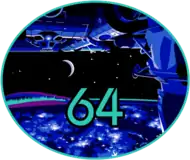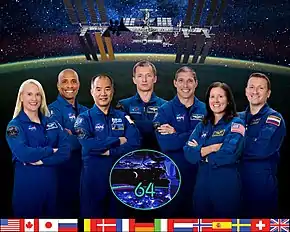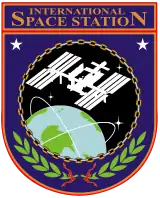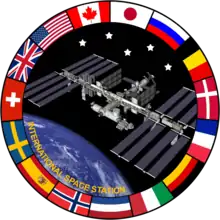Expedition 64
Expedition 64 is the 64th and current long-duration expedition to the International Space Station (ISS), that began on 21 October 2020 with the undocking and departure of Soyuz MS-16. The Expedition started with the three crew members launched onboard Soyuz MS-17 and reached its full complement with the arrival of SpaceX Crew-1, the first operational flight of NASA's Commercial Crew Program (CCP).[2] As Crew-1 consists of a crew of four instead of three like the Soyuz, Expedition 64 marks the beginning of operations for crews of seven on the ISS. In the final weeks of the mission, Soyuz MS-18 and its three cosmonaut crew are scheduled to join the mission. The expedition is scheduled to end on 18 April 2021 with the departure of Soyuz MS-17.[3]
| Mission type | Long-duration mission to the ISS |
|---|---|
| Operator | NASA / Roscosmos |
| Mission duration | 104 days, 7 hours and 3 minutes (in progress) |
| Expedition | |
| Space Station | International Space Station |
| Began | 21 October 2020, 23:32:00 UTC |
| Ended | 18 April 2021 UTC (planned) |
| Arrived aboard | Soyuz MS-17 SpaceX Crew-1 |
| Crew | |
| Crew size | 3-7 |
| Members | |
| EVAs | 3[1] |
| EVA duration | 19h04m |
 ISS Expedition 64 Patch  Expedition 64 crew portrait | |
Crew
| Position | October – November 2020 | November 2020 – April 2021 | April 2021 | |
|---|---|---|---|---|
| Commander | Second spaceflight | |||
| Flight Engineer 1 | Second spaceflight | |||
| Flight Engineer 2 | First spaceflight | |||
| Flight Engineer 3 | Second spaceflight | |||
| Flight Engineer 4 | First spaceflight | |||
| Flight Engineer 5 | Third spaceflight | |||
| Flight Engineer 6 | Second spaceflight | |||
| Flight Engineer 7 | Third spaceflight | |||
| Flight Engineer 8 | First spaceflight | |||
| Flight Engineer 9 | First spaceflight | |||
Extravehicular activity
Several spacewalks for Expedition 63 were planned to carry out work on the scientific and power systems on the ISS. Delays to the NASA Commercial Crew Program left Chris Cassidy as the only crew member on the US Orbital Segment (USOS) for an extended period of time. The arrival of the Crew Dragon Demo-2 mission permitted four EVAs by Cassidy and Robert Behnken to replace the remaining nickel-hydrogen batteries on the S6 Truss with new lithium-ion batteries.[4]
The planned work for activating the Bartolomeo scientific package located on the outside of the Columbus laboratory module, delivered on SpaceX CRS-20, was postponed until Expedition 64.[5]
Ryzhikov and Kud-Sverchkov performed a spacewalk on 18 November 2020 to conduct initial preparations for the replacement of the Pirs docking compartment by the Nauka laboratory module, which lasted 6 hours and 48 minutes. This was the first EVA to be conducted from the Poisk airlock.[6] Coverage of the spacewalk, which NASA has designated "Russian Spacewalk #47", began at 14:30 UTC and lasted more than six hours.[7]
References
- "ISS Expedition 64". 18 November 2020. Retrieved 1 February 2021.
- Burghardt, Thomas (17 November 2020). "Crew Dragon Resilience successfully docks, expands ISS crew to seven". NASASpaceflight.com.
- "Schedule of ISS flight events (part 2)". forum.nasaspaceflight.com. 24 March 2020.
- Corbett, Tobias (19 May 2020). "NASA outlines the near and far future of the Space Station". nasaspaceflight.com. Retrieved 21 May 2020.
- "Spacesuit Work and Heart Research Fill Crew Day – Space Station". blogs.nasa.gov.
 This article incorporates text from this source, which is in the public domain.
This article incorporates text from this source, which is in the public domain. - Potter, Sean (12 November 2020). "NASA TV Coverage Set for Russian Spacewalk" (Press release). NASA. Retrieved 14 November 2020.
 This article incorporates text from this source, which is in the public domain.
This article incorporates text from this source, which is in the public domain. - "NASA TV Main Page". NASA. 18 November 2020. Retrieved 18 November 2020.
 This article incorporates text from this source, which is in the public domain.
This article incorporates text from this source, which is in the public domain.

